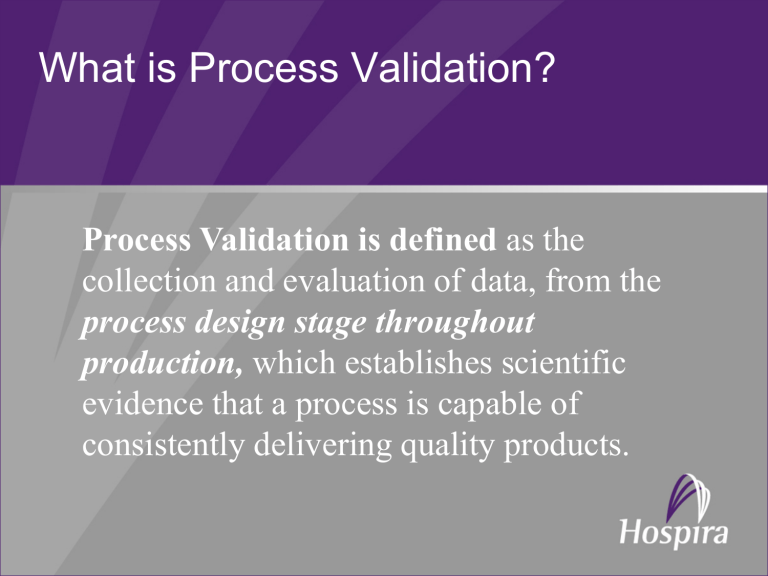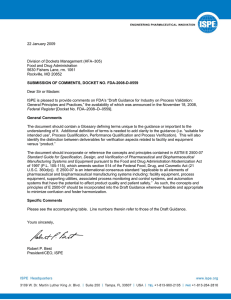What is Process Validation?

What is Process Validation?
Process Validation is defined as the collection and evaluation of data, from the process design stage throughout production, which establishes scientific evidence that a process is capable of consistently delivering quality products.
2
What is a Controlled Process?
Raw materials
In-process material
Environment
Control Strategy
Feed forward Feed back
Process Parameters
Real-time quality measurement
(Real-time-release)
Variable input
Constant output
End-product testing
Adaptable process
A Practical Approach to Process
Validation
4
What is it?
In January 2011
FDA issued the guidance for Industry:
Process Validation:
General Principles and Practices
… to replace the Process Validation guide from 1987
5
The New Guidance Promotes:
• Modern manufacturing principles
• Process improvement
• Innovation
• Sound science
• Risk Assessment and mitigation
The FDA Principle of Quality Assurance
6
...the principle incorporates the understanding that the following conditions exist:
• Quality cannot be adequately assured merely by in-process and finished-product inspection or testing .
• Quality , safety, and efficacy are designed or built into the product.
• Each step of a manufacturing process is controlled to assure that the finished product meets all design characteristics and quality attributes including specifications.
7
Product quality in the context of process validation means that product performance is consistent from batch-to-batch and unit-tounit .
8
The New Paradigm
Comparing 1987 with 2011
• FDA asking for more scientific arguments.
• Three is NOT a magic number.
• Apply a Life Cycle approach.
The 2011 guide collects several stand-alone activities in to one context: Process Validation .
9
Process Validation During the Product
Life Lifecycle Approach
• Overall validation is not completed but on-going .
• Recognises that more knowledge will be gained during commercial production.
• Necessitates comprehensive process design to understand sources of variability and achieve process understanding.
• Incorporates risk management .
10
Lifecycle approach links product and process development to the commercial manufacturing process, and maintains the process in a state-of-control during routine production .
11
The PV puzzle
– The 3 stages
1.
Process Design: The commercial process is defined during this stage based on knowledge gained through process development activities.
2.
Process Qualification: During this stage, the process design is confirmed as being capable of reproducible commercial manufacturing. Including qualification of the facility, utilities and equipment.
3.
Continued Process Verification: Maintenance, continuous verification, and process improvement. On-going assurance that routine production process remains in a state of control. Assessed by collecting and monitoring information during commercialisation.
12
Process Design
Conducting the Process Design
Process Knowledge Product Knowledge Understanding
• Learn, gain understanding of your process. Document all studies and activities.
• Retrospective review.
• Risk assessment of the process (selecting parameters, environment?).
• Design of Experiments (DOE)
• Modeling (predicting and confirming the process/parameter behavior).
• lab, engineering, pilot, small scale and commercial scale studies.
13
Process Design (continued)
Establish a Control Strategy
Break down process into segments for each unit operation and the process overall.
Strategy considerations:
• The commercial production and control records
• The operational limits
• Regulatory constraints
The Control Strategy should be carried forward to the next stage (PQ) for confirmation.
14
Evaluate your current Design Phase
15
Process Design
Where are we today?
• What type of information is gathered during the design phase?
• How does this information help to ensure that product is produced consistently every time?
• How well do you know your process / product?
• What’s in the Technology Transfer Package?
16
Process Design – Stage 1 output:
• Verification/determination of the limits for the critical process parameters.
• The limits/process boundary have been validated.
• Knowledge of process variable is gained, enabling the establishment of control strategy .
17
Process Qualification
Successful completion of this stage is necessary before commercial distribution.
The process qualification stages covers:
• Design of the facility and qualification of equipment
• Performance qualification
• PPQ protocol
For all activities during the Process Qualification – cGMP procedures must be followed.
18
Design and PQ
110
Finished Product
108
106
104
102
100
98
96
94
92
90
Point 1 Point 2
104
In-process Bulk
103
102
101
100
99
98
97
96
Point 1 Point 2
Point 3
Point 3
19
Process Qualification (continued)
• Three is not a magic number…The past and the present and the future. You no longer get three as a magic number.
• The approach to PQ should be based on the overall product and process understanding .
• The PQ lots should be manufactured under normal conditions by personal expected to routinely perform each step.
• The manufacturer should judge whether it has gained sufficient understanding to provide a HIGH degree of assurance in its process to justify commercial distribution of the product.
20
Evaluate your current Process
Qualification Phase
21
Process Qualification
Where are we today?
• Do I have confidence in my manufacturing process?
• What scientific evidence assures me that my process is capable of consistently delivering quality product?
• How do I demonstrate that my process works as intended?
22
Process Qualification – Stage 2 output:
A successful PQ will confirm the process design and demonstrate that the commercial manufacturing process performed as expected.
23
Continued Process Verification
The goal of this stage is to continually assure that the process remain in a state of control during commercial manufacture.
• In 1987 it is was called Revalidation or Requalification.
• In 2011 a more broad focus should be applied.
• An ongoing program must be established to collect and analyse product and process data .
• The information collected should verify that the critical
quality attributes are being controlled throughout the process.
24
Continued Process Verification
Once established, the equipment qualification status must be maintained through:
• Routine monitoring
• Maintenance
• Calibration procedures
And the data should be assessed periodically to determine whether re-qualification should be performed.
25
Continued Process Verification
On-going Sampling is part of the program:
• In the first phase of commercial production.
Continued monitoring and/or sampling at the level established during the process qualification stage.
• In the second phase of commercial production.
When sufficient data is available to generate significant variability estimates and the variability is known.
- sampling and/or monitoring should be adjusted to a statistically
appropriate and representative level.
26
Continued Process Verification
Process Optimisation
Data gathered during Stage 3 might suggest ways to improve and/or optimise the process.
The information and data about
• product performance
• manufacturing experience should be periodically reviewed to determine whether any changes to the established process are warranted .
• Modifications may warrant additional process design and process qualification activities.
27
Evaluate your current Continued
Process Verification Phase
28
Continued Process Verification
Where are we today?
• How do I know my process remains in control?
• What type of data is being collected?
• How often is this data reviewed?
• How do I react to trends in the data?
• What type of sample plan is in place?
29
Continues Process Verification
–
Stage 3 is on-going
• Collection and evaluation of information and
data about the performance of the process, will
allow detection of process drift .
• On-going feedback about product performance is
an essential feature of process maintenance.
30
The New Paradigm
– Where Are We Going? (continued)
With the new paradigm there is an increased focus on continually assuring that the process remains in at state of control.
• An on-going program - Continues Process Verification – must be established, where the purpose is to verify the critical quality attributes are being controlled throughout the process.
• The program should include relevant process trends, quality of incoming materials, in-process material, etc.
• Data should be statistically trended and review by trained personnel (SMEs).
31
Summary
1. Process Design
• Verify equipment and utilities “build and installation”
• Verify operation in all operating ranges
• Challenge in routine production: loads, interventions and stoppages
• Define critical attributes
2. Process Qualification (PQ)
•Combines qualified equipment and trained personnel with commercial manufacturing process, control procedures and components to produce commercial batches
3. Continued Process Verification
•Continually assure that the process remains in a state of control.
•Continued monitoring at the level established during PQ until significant data is available to generate significant variability estimates.
32
Where can I find the guide?
The guide is available on-line form the CDER website. http://www.fda.gov/downloads/Drugs/GuidanceComplianceRegulatoryInformation/Guidances/UC
M070336.pdf



